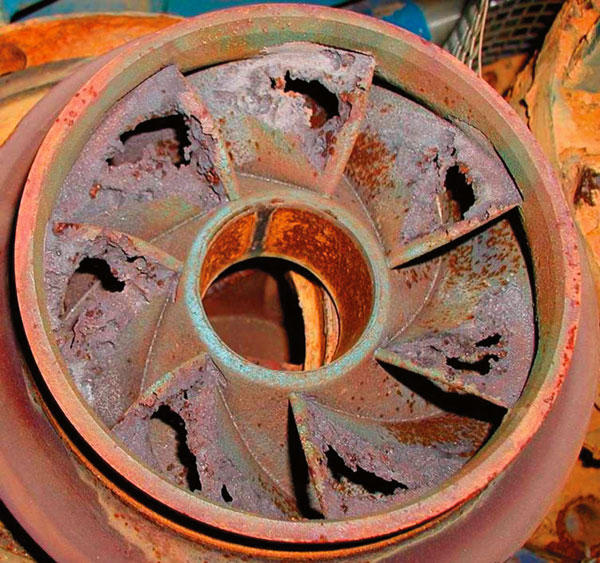Cavitation – an Introduction
- Cavitation is the formation of vapour cavities in a liquid, small liquid-free zones ((“
bubbles” or “voids”), that are the consequence of forces acting upon the liquid. - It usually occurs when a liquid is subjected to rapid changes of pressure that cause the formation of cavities in the liquid where the pressure is relatively low.
- Cavitation occurs in fluid flow systems where the local static pressure is below vapor pressure.
- Cavitation is a common problem in pumps and control valves – causing serious wear, tear and damage. Under the wrong conditions cavitation reduces components life time dramatically.
https://youtu.be/ON_irzFAU9c
What is Cavitation?
Cavitation may occur when local static pressure in a fluid reach a level below the vapor pressure of the liquid at the actual temperature. According the Bernoulli Equation this may happen when a fluid accelerates in a control valve or around a pump impeller.
Credit : https://gfycat.com/
Credit : https://gfycat.com/
The vaporization itself does not cause the damage – the damage happens when the vapor almost immediately after evaporation collapses when velocity decreases and pressure increases.
Avoiding Cavitation
Cavitation can in general be avoided by
- increasing the distance (pressure difference) between the actual local static pressure in the fluid – and the vapor pressure of the fluid at the actual temperature
How to prevent cavitation due to vaporization
For preventing cavitation in a pump following is the mentioned precautions :
NPSHa > NPSHr + 3 ft or more safety margin
- Lower the temperature.
- Raise the liquid level in the suction vessel.
- Change the pump.
- Reduce motor RPM if possible.
- Increase the diameter of the eye of the impeller.
- Use an impeller inducer.
- Reducing the temperature of the fluid
- Use two lower capacity pumps in parallel.
- Use a booster pump to feed the principal pump.
- Increasing the total or local static pressure in the system
Re-engineering of Components Initiating High Speed Velocity and Low Static Pressure
Cavitation and damage can be avoided by using special components designed for the actual rough conditions.
- conditions with huge pressure drops can – with limitations – be handled by Multi Stage Control Valves
- challenging pumping conditions with fluid temperatures close to the vaporization temperature can be handled with special pumps – working after other principles than centrifugal pumps
Increasing the Total or Local Pressure in the System
By increasing the total or local pressure in the system the distance between the static pressure and the vaporization pressure is increased and vaporization and cavitation can be avoided.
The ratio between static pressure and the vaporization pressure – an indication of the possibility of vaporization, is often expressed by the Cavitation Number.
Unfortunately it is not always possible to increase total static pressure due to systems classifications or other limitations. Local static pressure in components may be increased by lowering (elevation) the component in the system. Control valves and pumps should in general be positioned in the lowest part of a system to maximize the static head.
This is a common solution for boiler feeding pumps receiving hot condensate (water close to 100 oC) from condensate receivers in steam plants.
Reducing the Fluid Temperature
Vaporization pressure depends of fluid temperature. The vapor pressures for water – our most common fluid – are indicated below:
| Temperature (oC) |
Vapor Pressure (kPa, kN/m2) |
|---|---|
| 0 | 0.6 |
| 5 | 0.9 |
| 10 | 1.2 |
| 15 | 1.7 |
| 20 | 2.3 |
| 25 | 3.2 |
| 30 | 4.3 |
| 35 | 5.6 |
| 40 | 7.7 |
| 45 | 9.6 |
| 50 | 12.5 |
| 55 | 15.7 |
| 60 | 20 |
| 65 | 25 |
| 70 | 32.1 |
| 75 | 38.6 |
| 80 | 47.5 |
| 85 | 57.8 |
| 90 | 70 |
| 95 | 84.5 |
| 100 | 101.33 |
Note! – be aware that evaporation pressure – and possible cavitation – increases dramatically with water temperature.
Cavitation can be avoided by locating components to the coldest part of systems. Example – it is common to locate pumps and modulating valves in heating systems in the “cold” return lines before heaters and heat-exchangers.

